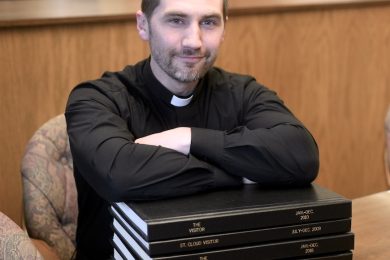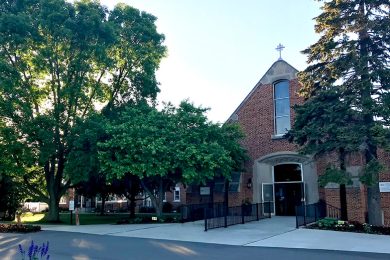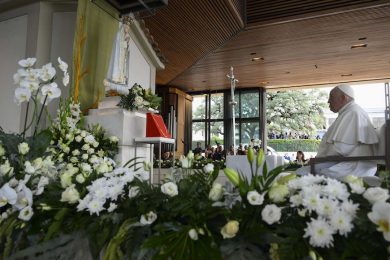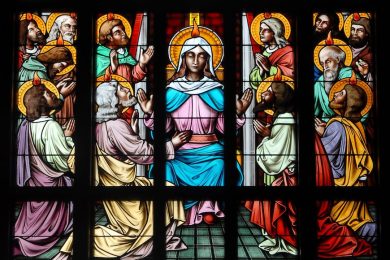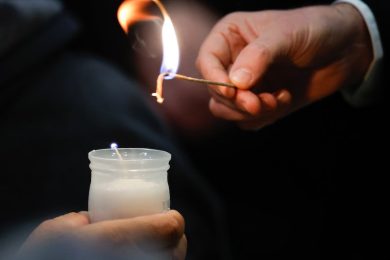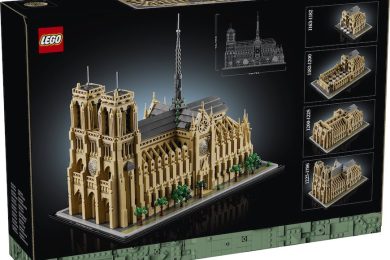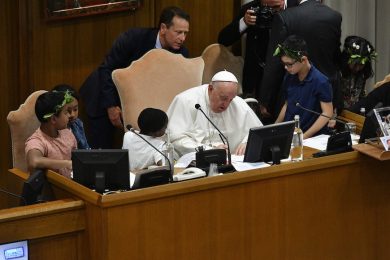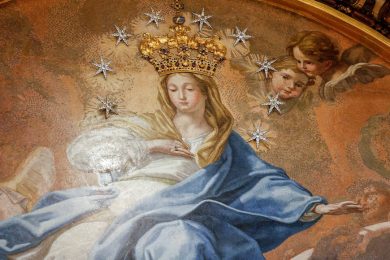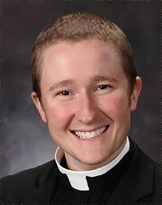
Advent and Christmas are seasons rich with opportunities for prayer and spending extra time with the Lord. Here Father Brady Keller, parochial vicar of St. Mary’s Cathedral, St. Augustine and St. John Cantius parishes in St. Cloud, along with a little help from the U.S. Conference of Catholic Bishops and other Catholic resources, takes a look at some of the common prayers of the seasons.
What is the Divine Office?
Also called the Liturgy of the Hours or the Breviary, the Divine Office is a compilation of psalms, hymns, prayers and other scriptural and spiritual writings. It originated in apostolic times as a continuation of the Jewish custom of praying the psalms in particular. Through the centuries, prayers, hymns and other writings were added.
WHY PRAY THIS WAY?
The purpose of the Divine Office is to sanctify the entire day to God. By praying all of it or even parts of it, you center your daily schedule around God by returning to him throughout the day in prayer.
SAMPLE OF LAUDS (MORNING PRAYER) SAMPLE FROM THE 1ST SUNDAY OF ADVENT:
ANTIPHON: On that day sweet wine will flow from the mountains, milk and honey from the hills, alleluia.
PSALM 62
O God, you are my God, for you I long; for you my soul is thirsting…
Glory to the Father and to the Son and to the Holy Spirit…
ANTIPHON: On that day sweet wine will flow from the mountains, milk and honey from the hills, alleluia.
To view the full prayer, download the iBreviary app or visit iBreviary.com.
What are some common blessings that people can pray at home during Advent and Christmas?
There are blessings for just about everything, including Advent wreaths, Christmas trees and Nativity sets. Why would we bless these items? To make them holy, or set apart for sacred use. By blessing an item, we are saying that we want this item to be used to glorify God. While some blessings are reserved to the clergy, the lay faithful, by virtue of their baptism, can bless many things as well.
WHY PRAY THIS WAY?
Individuals, couples and families might choose to place a wreath, tree or Nativity scene in a special place in their homes. There are many blessings that can be found online using trusted Catholic sources. This can be another reminder to keep Christ at the forefront of your celebrations and encourage a prayerful environment.
BLESSING THE FAMILY CHRISTMAS TREE
You may bless the tree as soon as you put it up, or you can wait until after you have decorated it. When you are ready to do the blessing, gather everyone around the tree and designate someone to lead the following prayer.
You will need water or holy water (if available) to celebrate this blessing.
LEADER: Loving God, we stand before you once again. We stand here ready to celebrate the birth of your son, Jesus.
(Have everyone extend a hand in a gesture of blessing. Sprinkle water or holy water on the tree while praying the following prayer.)
LEADER: Bless this tree, this sign of life and freshness and perseverance in our midst. It stands as a reminder that you are born anew in us each day. Bless our family and friends as we celebrate this joyous season. Keep us safe in our travels, kind in our conversations, and gracious in our giving and receiving. We ask you this in confidence, because we know you love us.
ALL: Amen.
(Join in singing a favorite Christmas carol, such as “O Christmas Tree” or “Joy to the World.”)
© Loyola Press. All rights reserved. 800-621-1008 Please review our Privacy Policy (https://www. loyolapress.com/general/privacy-policy) and Terms and Conditions (https://www.loyolapress.com/ general/terms-and-conditions).
What is a novena?
The word “novena” comes from Latin for the number nine. A novena is nine days of prayer devoted to a special occasion or intention. It draws its inspiration from the nine days that the Blessed Virgin Mary and Jesus’ disciples spent together in prayer between the Ascension and Pentecost.
WHY PRAY THIS WAY?
The St. Andrew Christmas Novena is a short prayer that can be easily memorized. You can then pray it multiple times throughout each day of the novena, recalling the holy moment when our Savior was born.
ST. ANDREW CHRISTMAS NOVENA:
Hail and blessed be the hour and moment in which the Son of God was born of the most pure Virgin Mary, at midnight, in Bethlehem, in the piercing cold. In that hour vouchsafe, I beseech Thee, O my God, to hear my prayer and grant my desires through the merits of Our Savior Jesus Christ, and His blessed Mother. Amen.
Why do we observe solemnities, feast days and memorials?
There are many solemnities, feasts and memorials throughout the liturgical calendar when we pray in a special way for the intercession of the saints. Many popular devotional practices involve the veneration of these saints. These holy men and women who have attained their heavenly reward have a special place in the Body of Christ which includes both the living and the dead. Through Christ’s work of breaking the bonds of death, we on earth remain in communion both with the saints in Heaven and with the dead who are still in Purgatory. (Source: USCCB)
WHY PRAY THIS WAY?
We can pray for those in purgatory and ask the saints in Heaven to pray for us. Our prayers help hasten the souls in purgatory on their road to heaven. Through their prayers of intercession, the saints in heaven play an integral role in the life of the Church on earth by bringing our petitions to God whom they now see face-to-face. (Source: USCCB)
SAMPLE OF PRAYER
On Dec. 12, the Church honors Our Lady of Guadalupe. Under this title, Our Lady is the patroness of Mexico, the United States and all of the Americas, as well as the protector of unborn children. In 1531, she appeared in a vision to the peasant Juan Diego on Tepeyac Hill near Mexico City and charged him with asking the bishop to build a church on that spot. But the bishop demanded a sign, so Our Lady had Juan Diego gather flowers in his cloak in December to take to the bishop. When Juan Diego opened his cloak, the colorful image of Guadalupe was emblazoned on the cactus-cloth. That icon is preserved in the most famous shrine in the Western Hemisphere, and Our Lady of Guadalupe continues to inspire poor and oppressed people worldwide. (Source: USCCB)
Holy Virgin of Guadalupe,
Queen of the Angels and Mother of the Americas.
We fly to you today as your beloved children.
We ask you to intercede for us with your Son,
as you did at the wedding in Cana.
Pray for us, loving Mother,
and gain for our nation and world,
and for all our families and loved ones,
the protection of your holy angels,
that we may be spared the worst of this illness.
For those already afflicted,
we ask you to obtain the grace of healing and deliverance.
Hear the cries of those who are
vulnerable and fearful,
wipe away their tears and help them to trust.
In this time of trial and testing,
teach all of us in the Church to love one another and to be patient and kind.
Help us to bring the peace of Jesus to our land and to our hearts.
We come to you with confidence,
knowing that you truly are our compassionate mother,
health of the sick and cause of our joy.
Shelter us under the mantle of your protection,
keep us in the embrace of your arms,
help us always to know the love of your Son, Jesus. Amen.
What is “lectio divina”?
“Lectio divina” is literally translated as “divine reading.” It is a way to dive deeper into a specific story or passage from Scripture. It involves reading and re-reading a passage, pausing to listen for God’s voice, meditating on what God might be whispering to the reader and reflecting on its meaning. It dates back to early monastic traditions.
WHY PRAY THIS WAY?
According to the Catechism of the Catholic Church, “Meditation engages thought, imagination, emotion and desire. This mobilization of faculties is necessary in order to deepen our convictions of faith, prompt the conversion of our heart, and strengthen our will to follow Christ. Christian prayer tries above all to meditate on the mysteries of Christ, as in ‘lectio divina’ or the rosary. This form of prayerful reflection is of great value, but Christian prayer should go further: to the knowledge of the love of the Lord Jesus, to union with him.”
HOW TO PRAY LECTIO DIVINA
- The first element of this type of prayer is reading (“lectio”): you take a short passage from the Bible, preferably a Gospel passage, and read it carefully, perhaps three or more times. Let it really soak in.
- The second element is meditation (“meditatio”). By using your imagination, enter into the Biblical scene in order to “see” the setting, the people and the unfolding action. It is through this meditation that you encounter the text and discover its meaning for your life.
- The next element is prayer (“oratio”) or your personal response to the text: asking for graces, offering praise or thanksgiving, seeking healing or forgiveness. In this prayerful engagement with the text, you open yourself up to the possibility of contemplation.
- Contemplation (“contemplatio”) is a gaze turned toward Christ and the things of God. By God’s action of grace, you may be raised above meditation to a state of seeing or experiencing the text as mystery and reality. In contemplation, you come into an experiential contact with the One behind and beyond the text. (Source: USCCB)
What is adoration?
Adoration is the worship given to God alone. It is the recognition that God is God and I am not, that God is my creator and I am his creature. We express adoration through prayers, bodily postures (prostration, genuflection, etc.) and acts of reverence and sacrifice (“offering it up”).
WHY PRAY THIS WAY?
“O Come Let Us Adore Him” is a well-known refrain commonly sung during the Christmas season. Eucharistic adoration, while observed year-round, can be another way to ready ourselves for Christ’s birth.
WHERE TO LEARN MORE
Check your local bulletin to see when your parish offers eucharistic adoration. Many parishes around the diocese offer perpetual adoration.
What is contrition?
Contrition is sorrow for one’s sins. It is either imperfect (sorrow for sin out of fear of punishment) or perfect (sorrow for sin because it offends God). We express contrition in the liturgy in the penitential act and through the use of violet vestments and decorations.
WHY PRAY THIS WAY?
Contrition, whether imperfect or perfect, is a necessary part of receiving forgiveness in the sacrament of reconciliation. Advent is a particularly appropriate time to receive this sacrament for two reasons: 1) because we prepare to celebrate the birth of Christ, who brought us forgiveness for our sins and 2) because we prepare for Christ’s Second Coming at the end of time when we will give an account of our lives.
WHERE TO LEARN MORE
In most parishes, extra confession times are offered during Advent. Penance services are also frequently offered during Advent. These services are a way for several priests to come together and offer the sacrament of reconciliation in a more communal setting. Scripture readings are proclaimed, an examination of conscience is done, individual private confessions and absolution are offered and a closing prayer is prayed. Check your local parish bulletin for confession times.
What are O Antiphons?
The Roman Church has been singing the “O” Antiphons since at least the eighth century. They are the antiphons that accompany the Magnificat canticle of Evening Prayer from Dec. 17-23. They are a magnificent theology that uses ancient biblical imagery drawn from the messianic hopes of the Old Testament to proclaim the coming Christ as the fulfillment not only of Old Testament hopes, but present ones as well. Their repeated use of the imperative “Come!” embodies the longing of all for the Divine Messiah. Source: (Source: USCCB)
WHY PRAY THIS WAY?
Praying the O Antiphons is one way to become closer to God during Advent. Calling to mind the different names used in this prayer helps us to know who Jesus is and understand more fully his role in Scripture, in the world and in our own lives.
THE O ANTIPHONS
DECEMBER 17
O Wisdom of our God Most High, guiding creation with power and love: come to teach us the path of knowledge!
DECEMBER 18
O Leader of the House of Israel, giver of the Law to Moses on Sinai: come to rescue us with your mighty power!
DECEMBER 19
O Root of Jesse’s stem, sign of God’s love for all his people: come to save us without delay!
DECEMBER 20
O Key of David, opening the gates of God’s eternal Kingdom: come and free the prisoners of darkness!
DECEMBER 21
O Radiant Dawn, splendor of eternal light, sun of justice: come and shine on those who dwell in darkness and in the shadow of death.
DECEMBER 22
O King of all nations and keystone of the Church: come and save man, whom you formed from the dust!
DECEMBER 23
O Emmanuel, our King and Giver of Law: come to save us, Lord our God!
— From Catholic Household Blessings & Prayers
What is a litany?
A litany is a form of prayer consisting of a series of petitions with fixed responses, such as “Pray for us” or “Hear us, O Lord.” There are many different litanies throughout the liturgical year.
WHY PRAY THIS WAY?
Litanies foster a meditative spirit with its repetitive structure. In particular, the litany of the Holy Name of Jesus focuses our attention on that name above all names. It would be appropriate to pray this litany in the Christmas season leading up to January 3, the feast of the Holy Name of Jesus, commemorating the day Joseph and Mary gave Jesus his name.
A SAMPLE OF THE LITANY TO THE MOST HOLY NAME OF JESUS
Lord, have mercy.
Christ, have mercy.
Lord, have mercy.
God our Father in heaven, have mercy on us…
God the Son, have mercy…
Redeemer of the world
God the Holy Spirit
Holy Trinity, one God
Jesus, Son of the living God
Jesus, splendor of the Father
Jesus, brightness of everlasting light
Jesus, king of glory
Jesus, dawn of justice
Jesus, Son of the Virgin Mary
Jesus, worthy of our love…
To see this prayer in its entirety, visit www.usccb.org and search for Litany to the Most Holy Name of Jesus.
Photo credit: Four lit candles are set in a wreath for Advent. One candle is lit each Sunday leading up to Christmas. (CNS photo/Nancy Wiechec)


